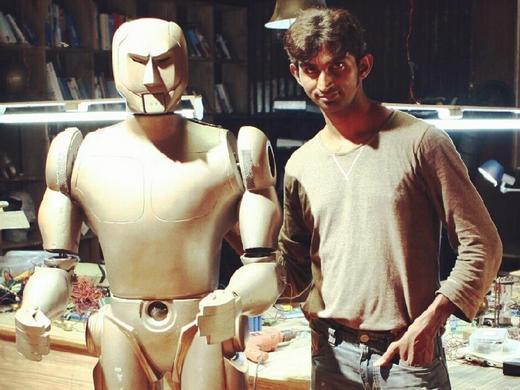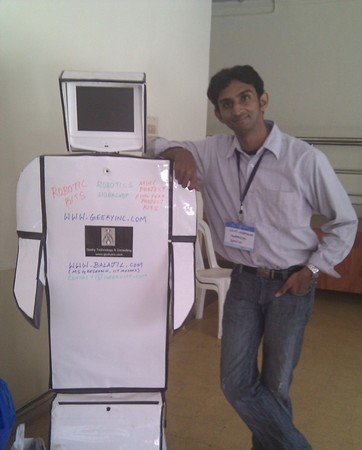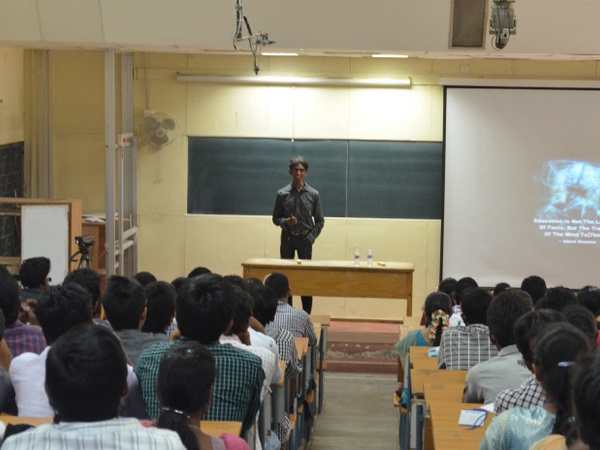 | « Back to article | Print this article |
He quit his job to build robots!
Balaji Lakshmanan an IIT-Madras alumnus quit a cushy job at Wipro to pursue his dream of building robots that'll make our lives easier. His clients? Cognizant and the Indian Army among others. Read on!
Students of VTU and Anna university colleges will vividly remember that period of year where colleges all around conduct symposiums.
Every student wants to present a “paper” which is usually something taken off Wikipedia.
I remember one such incident back in college, when a girl gave a presentation on an ARM processor’s architecture in an environment technology symposium. Worst part was that she won that competition.
I lost all my faith in these competitions and never attended a college symposium ever since.
But to think that it was one such college symposium that made Balaji Lakshmanan take up robotics, restores some faith in the system.
When he’s not trying to write his thesis for his PhD programme from IIT Madras, Balaji is building robots for the likes of Cognizant Technologies and the Indian Army, publishing papers at IEEE conferences and reviewing robotics paper entries to conferences of similar features.
He is possibly one of the country’s brightest talents in the field of robotics. Meet, Balaji Lakshmanan aka RoboBalaji.
A 'brainless' crane
Back in 2003, on a rainy evening, Balaji and his friends from college had plans made to go watch a movie.
Balaji got stuck in traffic and arrived late, much to the annoyance of his friend. The traffic jam, Balaji shared, was caused because of a construction crane which required a driver to move it.
Balaji says, “I thought if the crane was intelligent enough to move without requiring the driver, the traffic jam could have been avoided.”
Balaji took it upon himself to make that crane, which would be his first robot.
It was a computer controlled robot which could be programmed to run automatically as well as be controlled over the web. Balaji would take this from symposium to symposium earning lot of accolades from whoever saw it.
As time went on, he even made the crane run over a GPRS connection with those Rs 500 reliance phones. This particular variant of the robot won a prize in a nationwide competition at IIT Kanpur.
Being from a computer science background Balaji admits that he found it difficult initially to build his robot.
He says, “It’s a combination of electronics, mechanical and a fair bit of design thinking; all of which I had to pick up from friends and resources. But the way I see it, I think along with interest you need to be committed to it. You must really want to stick to getting something done and I stuck to getting that robot made.”

Please click NEXT to continue reading...
He quit his job to build robots!
No, this isn’t about his robotics venture.
After college, Balaji got a job at Wipro and much to his dismay, he was put into Java programming.
He says. “I went pillar to post through people I knew at Wipro so that they would change my department to the embedded systems labs, but no one did it. So I wrote to the senior most HR at Wipro about my interests and accomplishments in Robotics, requesting him to shift me to the embedded systems department. The next day I was moved to the embedded systems department.”
But this was short lived.
The only reason he joined a job was so that he could write the GATE examination and make it to IIT.
He says, “In my time with the embedded systems department at Wipro I worked as a research associate at RISE LAB in IIT Madras under the tutelage of Dr Ravindran and Dr Kamakoti. They were pretty impressed with what I knew and for me it was a really big learning experience. I really wanted to come back to this place.”
So badly he wanted to come back, that he paid Wipro Rs 70,000 to quit and write GATE.
He says, “Now when I look back to what I did, it seems like a huge risk that I took. Luckily for me, I cracked GATE and got to work with Dr Ravindran again, in the same department.”
Balaji credits the institution and his mentors with giving him a free hand in terms of funding and permissions.
He says, “This really prepared me well for the entrepreneurial venture that I was about to embark upon.”
However, Balaji is yet to hand in his thesis for the PhD programme. Meanwhile he is pursuing his entrepreneurial dream quite seriously -- that of designing and building robots.
He says, “When someone asks me what I did at IIT, I still say I researched and studied there. I don’t say I graduated. But my professors are to this day supportive of my decision.”
He quit his job to build robots!
Balaji shared that even as a student at IIT-M, he had already incorporated a company, back in 2008.
He says, “I knew this is what I wanted to do. I started doing a few things in robotics by then and I had applied and got selected for the Stanford Entrepreneurship summit. It was a two week program, where I was really exposed to how successful companies work. We were taken to Google’s office in Mountain View, the former HR head of Apple, founder of design firm IDO were just some of the people whom we spoke to. It was really inspiring. At the end of that course, I began to believe that I was going in the right way.”
In April 2008, Balaji began to attract attention from various companies because of his expertise in robotics.
He says, “My first order came from Cognizant technologies because they had heard of my work in intelligent and remote robotics.”
Post this, Balaji worked on many projects, such as building a humanoid for a Tamil movie, animatronics for other movies, robotic fingers for prosthetics and even built a robot for the Indian Army.
However Balaji admits that his entrepreneurial journey hasn’t been easy.
He says, “It’s very different from the academic environment and it took me fair bit of learning to come to terms with the real world.”
He quit his job to build robots!
Balaji also teaches building robots to children whenever he gets the time.
He says, “I try to keep it as hands on as possible. Rather than giving them some presentations with information, I try to get them to build a full robot at the end of the class. It’s very unconventional; I teach them the way I learnt to build a robot.”
Balaji believes that it is a lot easier to learn robotics today, as opposed to ten years ago, when he was starting out.
He says, “What took me six months to build, with today’s resources, we build in the classes that I take in six hours. Also, people in this field are very accessible. You can leverage much larger networks now. I get at least one mail everyday requesting assistance in learning robotics. I guess all you need today is interest and motivation.”
To all robotics enthusiasts out there, Balaji’s advice is singular.
He says, “Just make your first robot. The framework is similar for most other robots; placing certain motors slightly differently would make a completely different robot for you. Even if you don’t want to do this as a career, do it anyway. It is a great avenue to unleash your creativity; for example, 10 different people working with the same equipment can come up with 10 different robots at the same time. Also, it involves a lot of common sense, which is always a good thing.”
So when are you taking up robotics?



